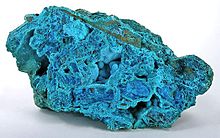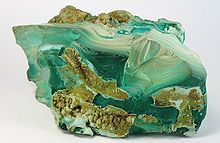- Chrysocolla
-
Chrysocolla 
Chrysocolla from AustraliaGeneral Category Silicate mineral Chemical formula (Cu,Al)2H2Si2O5(OH)4·nH2O Strunz classification 9.ED.20 Unit cell a = 5.7 Å, b = 8.9 Å, c = 6.7 Å Identification Color Blue, blue-green, green Crystal habit Massive, nodular, botryoidal Crystal system Orthorhombic Cleavage none Fracture Irregular/uneven, sub-conchoidal Tenacity Brittle to sectile Mohs scale hardness 2.5 - 3.5 Luster Vitreous to dull Streak white to a blue-green color Diaphaneity Translucent to opaque Specific gravity 1.9 - 2.4 Optical properties Biaxial (-) Refractive index nα = 1.575 - 1.585 nβ = 1.597 nγ = 1.598 - 1.635 Birefringence δ = 0.023 - 0.050 References [1][2][3] Chrysocolla is a hydrated copper silicate mineral with formula (Cu,Al)2H2Si2O5(OH)4·nH2O.
Contents
Properties
Chrysocolla has a blue-green color and is a minor ore of copper, having a hardness of 2.5 to 3.5.
Name and discovery
The name comes from the Greek chrysos, "gold", and kolla, "glue", in allusion to the name of the material used to solder gold, and was first used by Theophrastus in 315 BCE.
Formation and occurrence
It is of secondary origin and forms in the oxidation zones of copper ore bodies. Associated minerals are quartz, limonite, azurite, malachite, cuprite, and other secondary copper minerals.
It is typically found as botryoidal or rounded masses and crusts, or vein fillings. Because of its light color, it is sometimes confused with turquoise.
Notable occurrences include Israel, Democratic Republic of Congo, Chile, Cornwall in England, and Arizona, Utah, New Mexico and Pennsylvania in the United States.
 Powder-blue chrysocolla as stalactitic growths and as a thin carpet in vugs inside a boulder of nearly solid tyrolite. Size: 14.1 x 8.0 x 7.8 cm. Locality: San Simon Mine, Santa Rosa-Huantajaya District, Iquique Province, Chile
Powder-blue chrysocolla as stalactitic growths and as a thin carpet in vugs inside a boulder of nearly solid tyrolite. Size: 14.1 x 8.0 x 7.8 cm. Locality: San Simon Mine, Santa Rosa-Huantajaya District, Iquique Province, Chile
References
Categories:- Copper minerals
- Phyllosilicates
- Orthorhombic minerals
Wikimedia Foundation. 2010.

